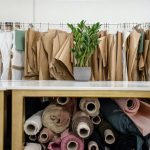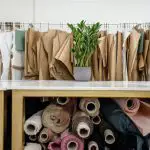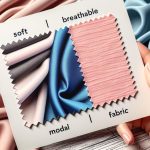I've got the scoop on modal fabric for you! It's a type of textile made from the cellulose of beech trees. Known for its ultra-soft feel and impressive durability, it's a stellar pick for comfort and eco-friendliness. Modal outshines many fabrics with its natural stretch and high breathability, making it perfect for things like towels and sportswear. It's especially popular in the eco-conscious fashion scene due to its sustainable production practices, including a closed-loop process that minimizes environmental impact. Curious about how modal stands up against other fabrics or its use in different products? Stick around, and I'll share some more insights!
Table of Contents
Key Takeaways
- Modal is a type of fabric made from the cellulose of beech trees.
- It is known for its softness, stretchability, and breathability.
- Modal is used in various textiles like sportswear, towels, and bed sheets.
- It is produced using environmentally friendly processes, often in a CO2-neutral environment.
- Modal fabric is part of the rayon family, with characteristics distinct from traditional viscose.
Defining Modal Fabric
Modal fabric, made from beech tree cellulose, is renowned for its softness and breathability. It's a top pick for anyone seeking comfort without compromising on eco-friendliness. The process of turning beech tree cellulose into this luxurious fabric is intriguing, especially considering its minimal environmental impact.
Here's the scoop: the production process of modal fabric is a big win for sustainability. It's not just about using less water than cotton—which, by the way, it does phenomenally, slashing water use by 10-20 times. It's also about the efficiency and the recycling practices involved. At places like Lenzing in Austria, where they produce modal, up to 95% of the materials used are recycled. That's a huge deal because it dramatically reduces waste and conserves resources.
Now, why do I lean towards modal fabric? Beyond its environmental perks, this fabric feels amazing, lasts long, and handles moisture like a champ. Plus, it maintains its shape and drapes beautifully. Whether it's for fashion or comfort, choosing modal is a smart move for both the planet and your wardrobe. It's a prime example of how we can enjoy luxury without leaving a hefty ecological footprint.
Origins and Production
I'll dive into how modal fabric is produced, starting with the sustainable harvesting of beech trees in Europe. Specifically, these trees grow abundantly in Northern and Central Europe, like in Austria, where they flourish without needing artificial irrigation or replanting. This natural regeneration makes beech trees a prime example of sustainability in textile production.
Moving on to the modal production itself, the process is remarkably eco-friendly, especially at facilities like Lenzing AG in Austria. Here, modal is produced in a CO2 neutral environment. This means that the carbon footprint is drastically reduced, aligning with global efforts to combat climate change. Furthermore, Lenzing leverages up to 95% recycled production materials, minimizing waste and environmental impact.
A key aspect of modal's eco-conscious production involves the closed-loop solvent system. This system is a game-changer as it recycles the chemicals used in converting beech tree cellulose into soft, luxurious fibers. By recapturing and reusing solvents, Lenzing ensures that modal production isn't only sustainable but also responsible. This approach helps in maintaining the balance between achieving high-quality textile production and preserving our environment.
Key Properties of Modal
Now let's look at why modal fabric is so admired for its unique qualities.
First off, it's made from beech tree cellulose, which not only gives it a leg up in the eco-friendly department but also contributes to its incredible properties. The production process is designed to be low impact, preserving resources and reducing pollutants, which is something we all can feel good about.
What really sets modal apart is its natural stretch. Unlike some fabrics that might feel restrictive, modal moves with you, making it ideal for anything from yoga pants to comfy tees. Speaking of comfort, the ultra-soft feel of modal is almost second to none. It's so gentle on the skin that once you try it, it's hard to go back to anything less cozy.
Another standout feature is how water absorbent modal is. This fabric can soak up 50% more moisture than cotton, keeping you dry and comfortable throughout the day. It's not just about feeling good either; this feature makes modal a durable choice that maintains its color and texture wash after wash.
In essence, modal is the go-to for anyone looking for comfort, sustainability, and durability all rolled into one.
Modal Vs. Other Fabrics
Let's compare modal to other popular fabrics to see how it stacks up in terms of comfort, sustainability, and overall performance. Modal, a type of rayon made from beech tree cellulose, has a reputation for being luxuriously soft and breathable, much like silk, yet it's impressively durable like cotton.
Here's a quick comparison:
| Feature | Modal | Other Fabrics |
|---|---|---|
| Softness | Exceptionally soft | Varies |
| Sustainability | Highly sustainable | Less sustainable |
| Durability | High durability | Moderate to high |
Modal's ability to absorb water better than many other fabrics makes it ideal for towels and sportswear, ensuring comfort and functionality all in one. Due to its sustainable production process, modal is increasingly favored in eco-conscious fashion circles, setting it apart from less sustainable options like traditional cotton. Its draping quality also rivals that of silk, making it a go-to for garments that require a smooth, flattering fit.
As someone who's passionate about both the environment and maintaining a stylish wardrobe, I find modal's balance of eco-friendliness and performance truly impressive. It's a fabric that caters well to a refined taste, providing comfort without compromising on sustainability.
Environmental Impact
Modal's environmental impact is notably less harsh than that of viscose, primarily due to its use of reduced concentrations of caustic soda. When I'm looking into the eco-friendly credentials of fabrics, modal stands out because it involves less chemicals in its production process. This reduction is a big deal because caustic soda, used extensively in many fabric production cycles, is pretty nasty stuff. Its lower use in modal production means less environmental degradation and fewer health risks for workers.
Manufacturers only use cellulose from wood in producing modal, which suggests a natural and renewable foundation. However, not all wood used is guaranteed to come from sustainable sources unless it's certified by trustworthy organizations like Lenzing. This aspect is crucial because the source of the wood can significantly influence the environmental footprint of the final product.
While modal isn't organic, efforts to replace harsh chemicals with more organic solutions are ongoing. Carbon disulfide, for instance, has a bad rep for its environmental impact, and reducing its use in modal production is a step forward. It's essential to keep pushing for these advancements to ensure that modal remains a greener choice in the fabric industry.
Sustainability Practices
As we look at sustainability practices in modal production, it's clear that eco-friendly methods are at the forefront.
I'm intrigued by how modal uses significantly less water than cotton and how it manages resources long-term.
It's impressive that the production also incorporates recycled materials and strives for a CO2 neutral output.
Eco-Friendly Production Methods
Modal fabric stands out as an eco-friendly choice because it requires significantly less water and uses up to 95% recycled materials in its production. The production process uses innovative techniques, including a closed-loop solvent system, ensuring minimal environmental impact.
As an organic form of rayon, it's derived from beech tree cellulose. These trees naturally thrive without artificial irrigation, highlighting the fabric's sustainable nature. Additionally, being produced in a CO2 neutral facility enhances its environmentally-friendly credentials.
The entire approach not only conserves water but also maximizes the use of available resources, making modal a standout example of eco-conscious textile production. This commitment to sustainability makes modal highly appealing to those dedicated to environmental conservation.
Long-Term Resource Management
I'll focus now on how the long-term resource management of modal fabric production exemplifies sustainability practices.
Starting with beech trees, these are a sustainable source, growing naturally without needing artificial irrigation. The production at the Lenzing site in Austria highlights how modal champions eco-friendly production practices. This site operates on a CO2 neutral basis and recycles up to 95% of materials used.
Moreover, modal's approach involves significantly reduced water usage, about 10-20 times less than cotton. This efficient resource management not only conserves water but also minimizes the overall environmental impact. So, by relying on modal, we're embracing a fabric that supports our planet's health while still delivering quality and performance.
Common Uses of Modal
Due to its versatility, modal fabric is often chosen for a range of clothing and household items. Let's dive into why it's so popular. TENCEL™ Modal, a type of modal fabric, is renowned for its exceptional softness and breathability. These qualities make it an excellent choice for sportswear. Imagine wearing yoga pants that feel like a second skin and keep you cool and dry; that's the magic of modal in sportswear.
Beyond the gym, modal's properties are a hit in household textiles too. Its softness transforms bed sheets into a luxurious experience, rivaling even the finest silk. However, it's not just about comfort. Modal's blend with other fibers, like silk, enhances products, combining modal's practical benefits with silk's rich texture. This makes it a smart choice for those who appreciate both style and substance in their fabrics.
While it's not the go-to for highly absorbent items like bath towels—due to its lower absorbency—its use in other areas more than makes up for this limitation. From comfy loungewear to soft, inviting bed linens, modal is a powerhouse fabric that offers both functionality and a touch of luxury.
Care and Maintenance Tips
While we've seen how versatile modal is, let's look at how to keep it looking its best with some simple care tips. Given its roots in trees and its eco-friendlier production process, maintaining modal not only preserves your clothes but also respects the resources used in its creation. Whether it's part of your favorite underwear fabric ensemble or a staple tee, modal is remarkably easy to care for.
Here are three key tips to keep in mind:
- Washing Modal: Always check the label first. Modal can be washed in various water temperatures, but cooler water is generally better to maintain color and prevent shrinkage. It's safe to use in a washing machine with a gentle cycle.
- Drying Modal: Although modal is low-temperature dryer safe, air drying is a better option if you've got the time. It uses less energy and is gentler on the fabric, helping it retain its softness and shape longer.
- Storing Modal: Keep modal garments in a cool, dry place away from direct sunlight. This helps prevent mildew and color fading, ensuring your pieces stay fresh and vibrant for years to come.
Cost Comparison
Let's talk money and see how modal stacks up against cotton in terms of cost.
We'll look at initial prices and consider the long-term expenses of both fibers.
It's essential to see which one gives us more bang for our buck over time.
Modal Vs. Cotton Prices
Comparing the costs, modal fabric is typically pricier than cotton. The difference in pricing stems from various factors involved in their production. Modal, derived from wood, uses more complex and environmentally-friendly processes. These include the use of less toxic chemicals like sodium hydroxide, which is crucial in the fiber's creation.
To break it down:
- Source Materials: Modal requires specialized wood pulp, which contributes to a higher cost base compared to widely available cotton.
- Production Techniques: The environmentally-friendly production processes of modal, which aim to minimize chemical use, add to the cost.
- Market Demand: Modal's luxurious feel and lesser environmental impact drive its demand, often raising prices above those of more common cotton.
Long-Term Expense Analysis
Although modal fabric costs more upfront than cotton, it often proves more economical over time due to its durability.
Let's break it down: modal is made to last. It resists shrinking and pilling, which means you're not buying new tees every season. Less frequent replacements save cash in the long haul.
Plus, the color retention is top-notch. You know how some shirts look faded after a few washes? Not the case with modal. It keeps its color, looking fresh and new longer.
This all adds up to fewer shopping trips and less money spent on keeping your wardrobe up-to-date. Long-term, investing in modal could actually mean more savings.
Varieties of Modal Available
Several varieties of modal fabric are available, each known for specific properties and benefits. As someone deeply interested in the textile industry, you'll find this overview on modal types quite enlightening, especially if you're keen on making informed choices.
Here's a quick rundown of the main varieties:
- Standard Modal: This is the base form of modal, renowned for its silk-like softness. It's primarily made from beech tree cellulose and offers exceptional comfort and breathability.
- TENCEL™ Modal: Developed by Lenzing AG, this type stands out due to its eco-friendly production process. It not only retains the inherent qualities of standard modal such as softness but also emphasizes sustainability, which is a huge plus for eco-conscious consumers.
- HWM Rayon: Often referred to as high wet modulus rayon, this variety is similar to modal but has enhanced strength when wet, making it more durable for frequent washes.
Each type has its unique appeal, whether it's the sustainability credentials of TENCEL™ Modal or the enhanced durability of HWM Rayon. Understanding these can help you make choices that align with both your personal and professional values.
Certifications and Standards
When looking at modal fabric, it's important to consider the certifications and standards it meets. Approved eco-friendly labels and industry compliance codes tell us a lot about the environmental impact and ethical considerations of production.
I'll explore what certifications like TENCEL™ Modal signify, and why they matter to you as a consumer.
Approved Eco-Friendly Labels
To ensure you're buying eco-friendly modal, always check for approved environmental certifications and standards. It's crucial to know which labels signify that modal has been made through eco-friendly processes and responsible forestry practices. Here's a simple guide:
- TENCEL™ Modal: This label indicates that the modal is sourced from sustainably managed beech tree plantations.
- Oeko-Tex Standard 100: Ensures the textile is free from harmful chemicals, supporting safer and more sustainable clothing production.
- Forest Stewardship Council (FSC): Certifies that the forestry practices used are responsible, helping to maintain forests' biodiversity and ecological balance.
Industry Compliance Codes
Understanding industry compliance codes is key to recognizing which modal fabrics meet high environmental and ethical standards. When I'm picking modal, I make sure to check for products branded by Lenzing or TENCEL.
This isn't just about the brand; it's about trusting that Lenzing AG, a top producer, adheres to stringent sustainable practices and certifications. These ensure that despite the potential use of harmful chemicals in modal production, everything is managed responsibly.
It's crucial to support modal that comes from responsible forestry practices, significantly minimizing environmental impact. So, whenever you're shopping, looking for these certifications on modal products isn't just good practice—it's essential for making environmentally conscious choices.
Future of Modal Fabric
The future of modal fabric hinges on embracing sustainable production and responsible sourcing practices. With an increasing demand from eco-conscious consumers, the producers of modal are stepping up their game. They're turning towards methods where lyocell is made using organic solutions, shaping the norm for environmentally-friendly manufacturing processes.
To really get a handle on what's coming, here are three key trends shaping the future of modal fabric:
- Closed-Loop Production Systems: Modal manufacturers are pushing for processes where nearly all chemicals and water used can be recycled and reused. This drastically reduces waste and pollution, making the system more sustainable.
- Advancements in Eco-Friendly Treatments: Research is continuously being done to enhance modal's properties through sustainable means. This includes developing new methods to process the fabric using less energy and more benign chemicals.
- Stronger Supply Chain Transparency: Brands are now more than ever held accountable for their supply chains. This means ensuring that every step, from the forest to the fabric, adheres to strict environmental standards to maintain credibility and consumer trust.
These shifts aren't just good for the planet; they're what consumers are starting to demand. Staying ahead in the fabric industry means adapting, or getting left behind.
Frequently Asked Questions
What Type of Fabric Is Modal?
I've learned that modal is a type of fabric made from beech tree cellulose. It's known for being soft, breathable, and eco-friendly, often used in clothing like activewear for its moisture-wicking properties.
Is Modal as Good as Cotton?
I'd say modal's pretty competitive! It absorbs more moisture and offers better drape than cotton. It's also colorfast and eco-friendlier to produce. However, it might wrinkle and stretch more than cotton.
Is Modal as Bad as Polyester?
I'd say modal isn't as bad as polyester. It's more breathable, eco-friendly, and biodegradable. Unlike polyester, modal offers a sustainable option with a luxurious feel, making it better for the environment and wear.
What Is the Downside of Modal Fabric?
The downside of modal fabric is its tendency to wrinkle and stretch, which can affect its fit and appearance. However, its benefits like comfort and moisture absorption often outweigh these minor issues.
- How to Care For Mulberry Silk Fabric to Make It Last a Lifetime - June 21, 2025
- A Guide to Mulberry Home Fabrics: Exploring Iconic Designs & Collections - June 21, 2025
- Where to Buy High-Quality Mulberry Silk Fabric by the Yard Online - June 21, 2025





